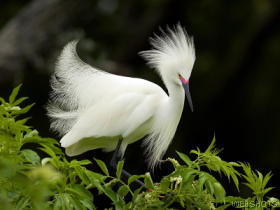
The term peafowl can refer to the two species of bird in the genus Pavo of the pheasant family, Phasianidae. The African Congo Peafowl is placed in its own genus Afropavo and is not dealt with here. Peafowl are best known for the male's extravagant tail, which it displays as part of courtship. The male is called a peacock, the female a peahen, though it is common to hear the female also referred to as a "peacock" or "female peacock". The female peafowl is brown or toned grey and brown.
The Indian Peafowl is a resident breeder in the Indian subcontinent. The peacock is designated as the national bird of India.
The Green Peafowl breeds from Myanmar east to Java. The IUCN lists the Green Peafowl as vulnerable to extinction due to hunting and a reduction in extent and quality of habitat.
The Indian Peafowl is monotypic, while the Green Peafowl has 3 subspecies, P. muticus spicifer, P. m imperator and the nominate P. m. muticus.
The two species are largely allopatric but will hybridise in captivity.
While the form of Green Peafowl in Yunnan is not separated taxonomically, it differs in a few aspects from other forms, particularly in its forest-dwelling habits, an "odd, monal-like bill", a curiously long hind toe and longer, more slender wings (K. B. Woods in litt. 2000). Some have suggested this is a new subspecies.
Some pheasant breeders have suggested that the Green Peafowl may have more subspecies.
Peafowl have sometimes been included in a distinct family from Pheasants.

The male (peacock) Indian Peafowl has iridescent blue-green or green coloured plumage. The so-called "tail" of the peacock, also termed the "train", is not the tail quill feathers but highly elongated upper tail coverts. The train feathers have a series of eyes that are best seen when the tail is fanned. Both species have a head crest.
The female (peahen) Indian Peafowl has a mixture of dull green, brown, and grey in her plumage. She lacks the long upper tail coverts of the male but has a crest. Females can also display their plumage to ward off danger to their young or other female competition.
The Green Peafowl is very different in appearance to the Indian Peafowl. The male has green and gold plumage and has an erect crest. The wings are black with a sheen of blue.
Unlike the Indian Peafowl, the Green Peahen is very similar to the male, only having shorter upper tail coverts and less iridesence. It is very hard to tell a juvenile male from an adult female.
Many of the brilliant colours of the peacock plumage are due to an optical interference phenomenon (Bragg reflection) based on (nearly) periodic nanostructures found in the barbules (fiber-like components) of the feathers.
Different colours correspond to different length scales of the periodic structures. For brown feathers, a mixture of red and blue is required: one color is created by the periodic structure, and the other is a created by a Fabry-Perot interference peak from reflections off the outermost and innermost boundaries of the periodic structure.
Such interference-based structural color is especially important in producing the peacock's iridescent hues (which shimmer and change with viewing angle), since interference effects depend upon the angle of light, unlike chemical pigments.
The peafowl are forest birds that nest on the ground. The Pavo peafowl are terrestrial feeders but roost in trees.
Both species of Peafowl are believed to be polygamous. However, it has been suggested that "females" entering a male Green Peafowl's territory are really his own juvenile or subadult young (K. B. Woods in litt. 2000) and that Green Peafowl are really monogamous in the wild. Those who subscribe to this notion cite the similarities between the sexes.
During mating season they will often emit a very loud high pitched cry.
Peafowl are omnivorous and eat plant parts, flower petals, seed heads, insects and other arthropods, reptiles, and amphibians.
In common with other members of the Galliformes, males possess metatarsal spurs or "thorns" used primarily during intraspecific fights.
Asiatic peafowl like the Indian Blue Peafowl and especially the Green Peafowl occupy a similar niche as the roadrunners, secretary bird, and seriema. All of these birds hunt for small animals including arthropods on the ground and tall grass and minnows in shallow streams.
Because of human encroachment into their natural territories, peafowl and humans have come into increasing contact. Because of their natural beauty some are reluctant to classify the birds as pests, but their presence can be disturbing.















































